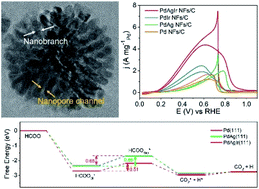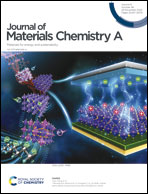Mesoporous PdAgIr nanoalloys to catalyze formate oxidation with an unprecedentedly low onset potential†
Abstract
Developing efficient catalysts with a low onset potential and exceptional stability toward the formate oxidation reaction (FOR) is highly crucial for practical scale-up of direct formate fuel cells, but still remains a formidable challenge. Herein, density functional theory calculations are first employed to investigate a PdAgIr nanoalloy and provide general guidance for designing advanced FOR catalysts. The theoretical thermodynamic analysis of the reaction energetics reveals that the incorporation of Ir into PdAg is capable of finely tuning the electronic structure of the PdAgIr(111) surface with a diminished energy barrier of 0.51 eV for the rate-determining step of the FOR, which then facilitates the quick dissociation of formate at an early anodic potential. Consistent with theoretical trends, the prepared PdAgIr nanoflower (PdAgIr NF) catalyst with ordered mesoporous architecture exhibits a record-low onset potential at 0.289 V and a superbly high mass activity of 4.36 A mgPd−1 toward the FOR benefitting from the unique functionality of Ir atoms, remarkably surpassing those of its Pd NF counterpart (0.558 V and 1.13 A mgPd−1). More surprisingly, for the first time, such a PdAgIr NF catalyst shows an unexpectedly wide oxidation current density platform for the FOR which has not ever been observed, suggesting its great potential for industrial applications.

- This article is part of the themed collection: Journal of Materials Chemistry A HOT Papers


 Please wait while we load your content...
Please wait while we load your content...